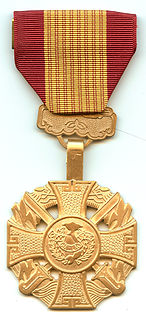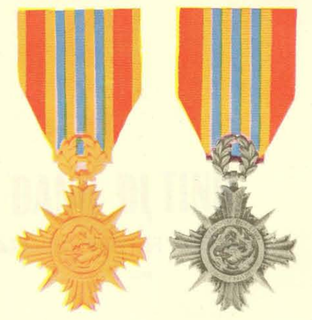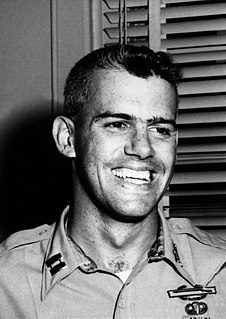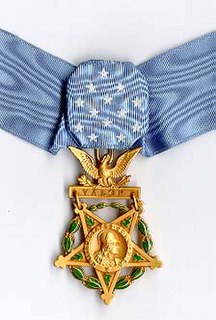
The Republic of Vietnam Gallantry Cross also known as the Vietnamese Gallantry Cross or Vietnam Cross of Gallantry is a military decoration of the former Government of South Vietnam. The medal was created on August 15, 1950 and was awarded to military personnel, civilians, and Armed Forces units and organizations in recognition of deeds of valor or heroic conduct while in combat with the enemy.

The Republic of Vietnam Campaign Medal also known as the Vietnam Campaign Medal is a military campaign medal which was created in 1949, and awarded to French military personnel during the First Indochina War. During the Vietnam War, the South Vietnamese government awarded the Republic of Vietnam Campaign Medal with Device to members of the South Vietnamese military for wartime service and on March 24, 1966, to members of the U.S. military for support of operations in Vietnam. In May 1966, other allied foreign military personnel became eligible for the award.
The Vietnam Service Medal is a military award of the United States Armed Forces established on 8 July 1965 by order of President Lyndon B. Johnson. The medal is awarded to recognize service during the Vietnam War by all members of the United States Armed Forces provided they meet the award requirements.

The National Order of Vietnam was a combined military-civilian decoration of South Vietnam and was considered the highest honor that could be bestowed upon an individual by the Republic of Vietnam government.
The Military Merit Medal was the highest military decoration bestowed to enlisted personnel by the Republic of Vietnam during the years of the Vietnam War. The medal was established on August 15, 1950. The Military Merit Medal was modeled after the French Médaille Militaire and was awarded mostly to Enlisted Men for valor in combat. The Vietnamese National Order of Vietnam was considered the equivalent decoration for military officers.

The Vietnam Distinguished Service Order was a military decoration of South Vietnam which was awarded throughout the years of the Vietnam War. The decoration was bestowed for meritorious or heroic deeds related to wartime operations and was awarded for both combat and non-combat service.

The Vietnam Air Gallantry Cross was a military decoration of South Vietnam which was issued during the years of the Vietnam War. The Air Gallantry Cross was awarded for meritorious or heroic conduct while engaged in aerial combat. The decoration was comparable to the United States decoration of the Air Medal.

The Vietnam Navy Gallantry Cross was a military decoration of South Vietnam which was issued during the years of the Vietnam War. The Navy Gallantry Cross was awarded to any member of the military who displayed meritorious or heroic combat while engaged in naval operations to benefit South Vietnam. The medal was awarded both for combat and non-combat service and was the equivalent of the United States Legion of Merit.

The Republic of Vietnam Wound Medal was a military decoration of South Vietnam first created in 1953. The medal was the South Vietnamese equivalent of the United States military's Purple Heart, and was awarded to any personnel of the South Vietnamese military who, while engaged in armed combat with enemies of the Republic of Vietnam, were either wounded or killed in action.

George B. Crist is a retired four-star general of the United States Marine Corps and was the first Marine to be designated as a Unified Commander — serving as Commander in Chief, United States Central Command from 1985 to 1988

The Republic of Vietnam Civil Actions Medal also known as the Vietnam Civil Actions Medal or Civil Actions Medal, is a military decoration of the former South Vietnamese government (1955–75). The medal was created on May 12, 1964 during the Vietnam War. The Civil Actions Medal was awarded to the South Vietnamese military and its allies' military personnel or units that performed outstanding achievements in the field of civil affairs. The medal was awarded in two classes, with the first class intended for commissioned officers and the second class for enlisted personnel. Individuals who were cited received the medal, ribbon, and a citation.

The Republic of Vietnam Armed Forces Honor Medal was a military decoration of South Vietnam that was first created on January 7, 1953. The medal was awarded in 1st and 2nd classes and reached its height of bestowals during the Vietnam War years. The medal was also one of the more commonly awarded medals to members of foreign militaries and was frequently bestowed to military advisors of the United States Armed Forces.
Authorized foreign decorations of the United States military are those military decorations which have been approved for wear by members of the United States armed forces but whose awarding authority is the government of a country other than the United States.

Awards and decorations of the United States Merchant Marine are civilian decorations of the United States which are issued to the members of the United States Merchant Marine for a variety of duties both in peace and war. Originally authorized to be issued by the War Shipping Administration of the World War II era, these awards were later issued by the Maritime Commission and are currently issued by the Department of Transportation's Martitime Administration.
Awards and decorations of the Vietnam War were military decorations which were bestowed by the major warring parties during the years of the Vietnam War. North Vietnam, South Vietnam, and the United States all issued awards and decorations during the conflict.

Captain Humbert Roque "Rocky" Versace was a United States Army officer of Puerto Rican-Italian descent who was posthumously awarded the United States' highest military decoration—the Medal of Honor—for his heroic actions while a prisoner of war (POW) during the Vietnam War. He was the first member of the U.S. Army to be awarded the Medal of Honor for actions performed in Southeast Asia while in captivity.

Franklin Douglas "Doug" Miller was an American and United States Army Special Forces staff sergeant during the Vietnam War who was awarded the United States military's highest decoration—the Medal of Honor—for his actions above and beyond the call of duty on January 5, 1970. He was also awarded a Silver Star, two Bronze Stars, and six Purple Hearts during his six years service in Southeast Asia.

Commencing with World War I, Puerto Ricans and people of Puerto Rican descent have participated as members of the United States Armed Forces in every conflict in which the United States has been involved. Accordingly, thousands of Puerto Ricans served in the Armed Forces of the United States during the Vietnam War, also known as the Second Indochina War. Hundreds of them died, either killed in action (KIA) or while prisoners of war (POW). The Vietnam War started as a Cold War, and escalated into a military conflict that spread to Vietnam, Laos, and Cambodia from 1959 to April 30, 1975.
Major General Michael D. Healy was a general officer in the United States Army who spent 35 years serving in the military, completing tours in Korea and Vietnam. Healy began his career with parachute training in Japan, then attended a number of Army Colleges, including Ranger School. He entered the Korean War as a Company Commander with the Airborne Rangers, a newly formed unit of the Army. Most of his career was spent in Vietnam, where he served five and a half tours, leading the 5th Special Forces group for almost 20 months, and earning him his first Distinguished Service Medal.
The system of Orders, decorations, and medals of South Vietnam came into being with the establishment of the National Order of Vietnam in 1950. Established by Bảo Đại, the head of state of the State of Vietnam, the order was the highest award of the state for both civilians and military personnel. This level of precedence continued under the government of South Vietnam. Lower ranking awards for both the military and civilians were subsequently established. The systems of civilian and military awards had their own order of precedence.
















